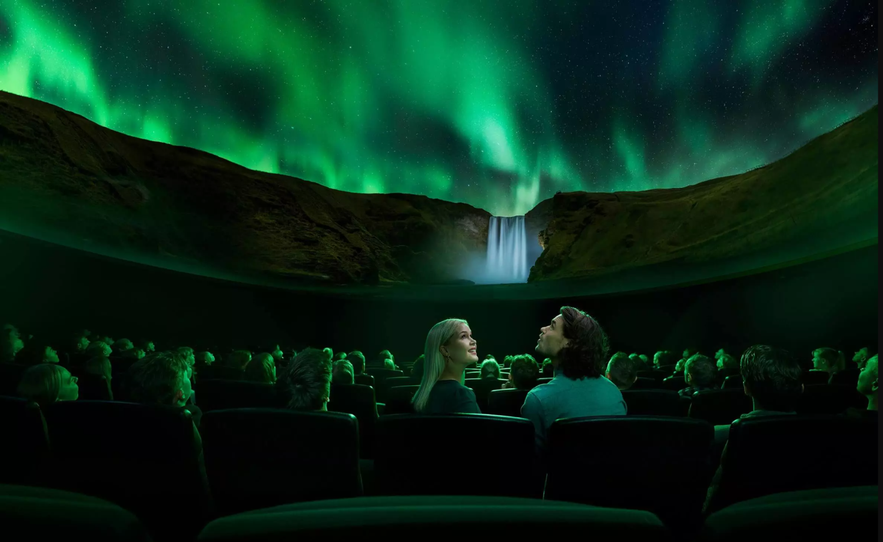
Best Places to See the Northern Lights in Reykjavik

- The Best Time to See the Northern Lights in Iceland
- Best Places to See the Northern Lights in Downtown Reykjavik
- Best Places to See the Northern Lights Around Reykjavik
- Locations close to central Reykjavik
- Locations further from Reykjavik
- Taking a Guided Northern Lights Tour from Reykjavik
- Self-Drive Tour vs. Guided Tour
- Preparing For a Northern Light Hunt
- Photographing the Northern Lights
- Optimal Conditions For Seeing the Northern Lights in Iceland
- Aurora forecasts
- What Are the Northern Lights?
- Visiting Aurora Museums in Reykjavik
- FAQs About the Seeing Northern Lights in Reykjavik
- Do I need special equipment to see the northern lights?
- Is it safe to drive in Iceland at night to watch the northern lights?
- What should I do if my guided northern lights tour gets canceled?
- Are there any indoor places where I can view the northern lights in Reykjavik?
- Do the northern lights have a sound?
- Summary of Seeing the Northern Lights in Reykjavik

Iceland's location within the Arctic Circle makes it one of the world's premier destinations to witness the northern lights. Its vast landscapes and minimal light pollution offer perfect backdrops for this celestial spectacle, and in the colder months, long, dark nights provide ample viewing opportunities.
Reykjavik is an especially convenient base for your northern lights hunt in Iceland. As the northernmost capital in the world, the city is close to numerous locations from which the aurora borealis can be observed, given the right conditions.
There are also plenty of options for comfortable accommodation in Reykjavik, and it's common to offer a wake-up service if the northern lights appear while you're sleeping! You can also stay at the special Reykjavik Domes that provide great views of the sky or at a nearby cozy cottage surrounded by Icelandic nature. To increase your chances, there are many northern light hotels around Iceland that offer a good chance to see the aurora, thanks to their great locations.
During your stay, you can set off on your own northern light self-drive tour with a rental car or choose to join a guided northern lights tour from Reykjavik for optimal convenience. No matter what you prefer, don't forget to make time to hunt for them if you're visiting Iceland in the fall or winter. Read on to find out everything you need to know about seeing the northern lights in Reykjavik!
The Best Time to See the Northern Lights in Iceland
 Iceland provides some of the best opportunities to witness the northern lights. They are typically visible from September to April, coinciding with dark, clear nights, though there is a chance you may spot them in early spring. The peak viewing season, however, is from November to early March, when the nights are the longest.
Iceland provides some of the best opportunities to witness the northern lights. They are typically visible from September to April, coinciding with dark, clear nights, though there is a chance you may spot them in early spring. The peak viewing season, however, is from November to early March, when the nights are the longest.
Late fall is a particularly advantageous period to chase the northern lights in Iceland. While the days are darkest during the height of winter, the weather can be particularly harsh. The relative mildness of the autumn weather compared to winter makes for a more comfortable aurora-hunting experience, as you may be staying outside for long periods of time.
During the autumn months, you may also be able to enjoy the varied self-drive summer tours of Iceland, depending on when you plan to visit. Alternatively, there are also many specialized winter tours and activities to choose from if visiting during the colder months.
Within the northern lights viewing period, the best time to see the aurora is usually around midnight, but they can appear anytime between sunset and sunrise. Weather plays a crucial role in visibility, with clear, cloudless skies being essential. Solar activity also affects the lights' intensity, with stronger solar winds leading to more vibrant displays.
It's important to remember that the northern lights are a natural event, and sightings can never be guaranteed on any given night. But with patience, a bit of luck, and preferably a warm drink, the experience of seeing them dance across the night sky is unforgettable.
- See more: Iceland in Fall - The Ultimate Travel Guide
- See more: Iceland in Winter - The Ultimate Travel Guide
- See more: Iceland in Spring - The Ultimate Travel Guide
Best Places to See the Northern Lights in Downtown Reykjavik
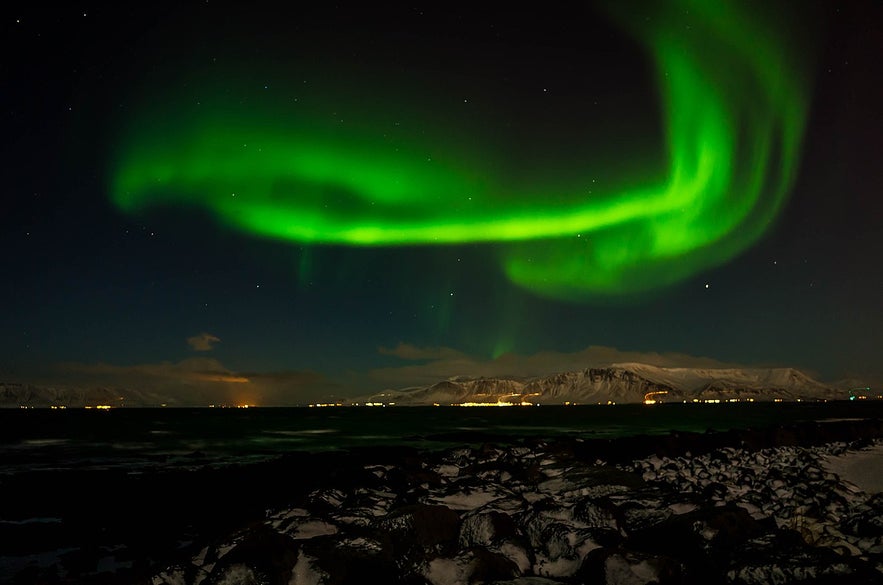
Photo from Wikimedia, Creative Commons, by sergejf. No edits made.
The great thing about northern light hunting in Iceland is that the aurora can be seen from virtually any place, given clear and dark skies. This means that the most stunning display could be waiting for you just around the corner from where you are staying, even in the heart of Reykjavik!
You can find several spots around Reykjavik that are great for viewing the northern lights, and many are a walking distance or a short bus ride away from the city center. Here are the best places for northern lights hunting close to downtown Reykjavik.
- Grotta: On the edge of the Seltjarnarnes peninsula, you'll find Grotta, a nature reserve along the coast that has an iconic lighthouse. Its relative seclusion from city lights, despite being close to the city center, makes it an ideal location for aurora hunting. It's about a 10-minute drive from central Reykjavik and 20 minutes by city bus. Walking takes about an hour along the scenic coastline.
- Perlan: Perlan, located on Oskjuhlid hill, offers an elevated vantage point for viewing the northern lights in Reykjavik. It provides panoramic views of the city and the skies above, making it a good spot for aurora watching, especially as it's just an 8-minute drive or 35-minute walk from the city center. Perlan itself is also a unique landmark worth exploring, featuring the exciting Perlan museum and the award-winning northern lights show at the Perlan Planetarium!
- Sun Voyager sculpture: The Sun Voyager sculpture, or Solfar, is an iconic landmark in central Reykjavik, making it a unique spot to view the northern lights. This steel sculpture, which represents a dreamboat and an ode to the sun, sits on the city's waterfront, providing an almost unobstructed view of the sky. If the conditions are right and luck is with you, you may even see the lights reflecting in the sea with Mt. Esja in the background!
- Klambratun: In the heart of Reykjavik, near Hlemmur, you'll find Klambratun park. This green public space, filled with trees and open areas, provides a good view of the night sky, which is essential for optimal northern light viewing.
- Grandi: Grandi is a district located by the old harbor in Reykjavik and has become a popular spot for northern lights viewing in recent years. Once an industrial area, it's now known for its trendy restaurants, unique shops, and cultural institutions, including the Aurora Museum. The district's revamped buildings can serve as interesting foregrounds to your northern lights images, as well as the Harpa Concert Hall, which can be seen towering over the harbor. It's around a 6-minute drive and a 25-minute walk from central Reykjavik.
Make sure to check out these convenient places during your fall or winter trip to Reykjavik for the chance to see the northern lights. Remember to dress warm and check the weather and aurora forecast before heading out.
Populære Kulturturer
24 timers Reykjavik Citykort med gratis adgang til museer, gallerier og geotermiske bassenger
10-dagers leiebiltur langs hele Ringveien på Island med de største attraksjonene og halvøya Snæfellsnes
Fleksibelt 48-timers Bykort for Reykjavik med gratis inngang til museum, gallerier og geotermiske bassenger
Best Places to See the Northern Lights Around Reykjavik
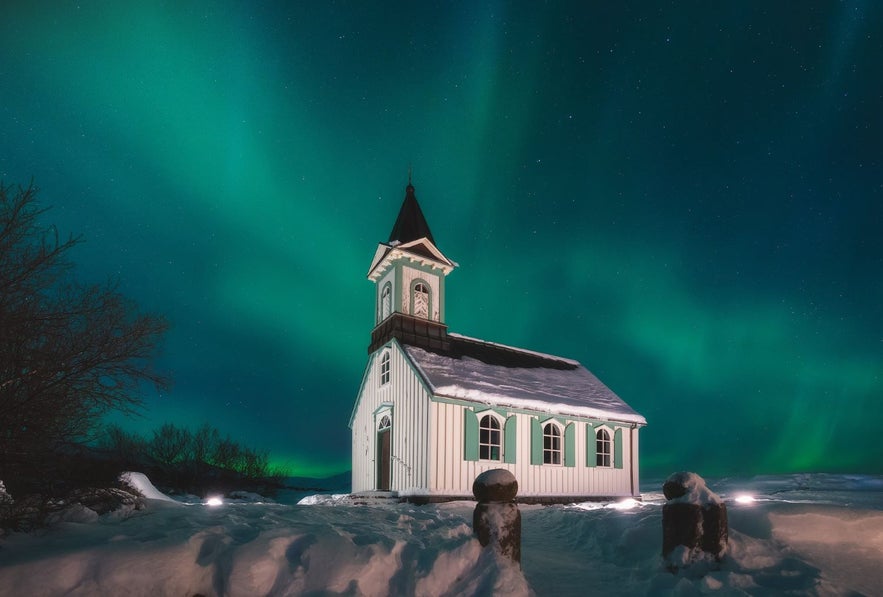 If you're planning on hunting for the northern lights yourself in Reykjavik, it's most conveniently done by rental car. In the fall, you can rent a small car, but in the height of winter, it's more convenient to rent a 4x4 vehicle. Doing so will give you more locations to choose from, and you'll be able to find less crowded spots around and close to the city. These locations are all less than an hour's drive away from central Reykjavik, and some are only a few minutes' drive away!
If you're planning on hunting for the northern lights yourself in Reykjavik, it's most conveniently done by rental car. In the fall, you can rent a small car, but in the height of winter, it's more convenient to rent a 4x4 vehicle. Doing so will give you more locations to choose from, and you'll be able to find less crowded spots around and close to the city. These locations are all less than an hour's drive away from central Reykjavik, and some are only a few minutes' drive away!
Locations close to central Reykjavik
- Ellidaardalur: Ellidaardalur is a popular valley and nature area within Reykjavik, surrounding the Ellidaa river. With its open spaces and distance from city lights, it offers a reasonably dark environment for aurora-watching. It takes around 12 minutes to drive there from the city center.
- Vifilsstadavatn: In the town of Gardabaer, a 15-minute drive from Reykjavik center, you'll find Vifilstadavatn, a serene lake and nature area. It's idyllic setting, proximity to the city, and relative seclusion from city lights make it an attractive spot for aurora hunters.
- Heidmork: Located on the outskirts of Reykjavik, Heidmork is a perfect spot for northern lights viewing. As a large nature reserve, it offers wide-open spaces and minimal light pollution for optimal aurora conditions. It boasts varied natural backdrops, like the Ellidavatn lake and the Raudholar pseudocraters, which can make for great photographs.
- Ulfarsfell: An adventurous spot for northern lights hunting is Ulfarsfell, a small mountain located in Mosfellsbaer, a 20-minute drive from downtown Reykjavik. With a higher vantage point and minimal light pollution, you may have a good chance of seeing the auroras dance across the sky. There are planned hiking paths to the top of the mountain, just make sure to be careful and bring a good flashlight or a headlight!

- Straumur: Straumsvik bay in Hafnarfjordur, also known as Straumur, is a popular and convenient spot to watch the northern lights as it's just a 25-minute drive from central Reykjavik. It offers a great view of the ocean from the edge of a lava field, and you'll also find some old houses in the area that make interesting photo opportunities. The location has reduced light pollution, which is great for viewing the auroras in the tranquility of the seaside.
- Hafravatn: The serene lake Hafravatn is a 25-minute drive from central Reykjavik and offers an excellent spot for viewing the northern lights away from the city. Its tranquil, dark surroundings offer good conditions for seeing the auroras. In the vicinity, the smaller lake of Reynisvatn offers a similarly peaceful, rural setting for a striking show.
- Hvaleyravatn: Lake Hvaleyravatn is a serene lake located near the charming town of Hafnarfjordur. It's only a 25-minute drive from Reykjavik, offering dark skies which enhance your chances of spotting the aurora. As a bonus, its peaceful surroundings also make it a perfect spot for stargazing, adding to the overall celestial experience.
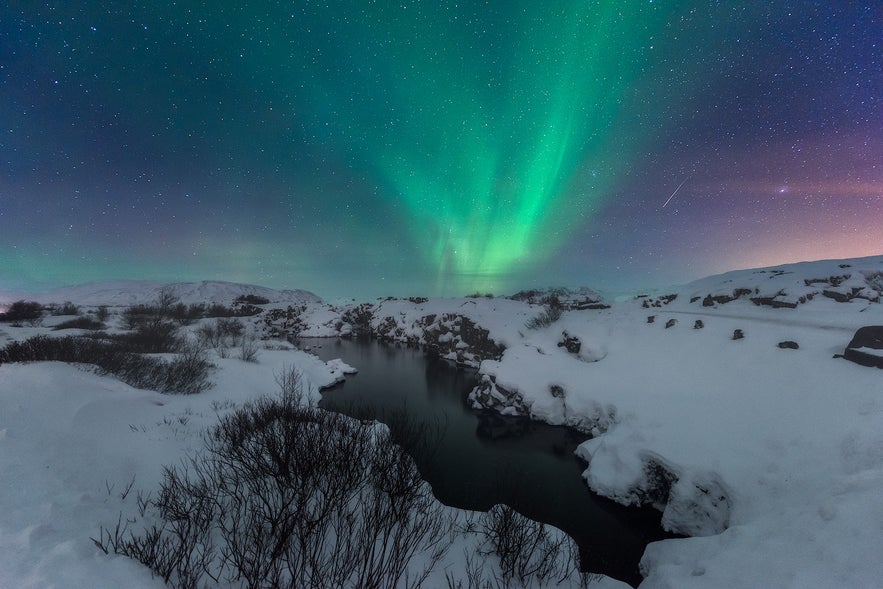
- Mt. Esja: Across the bay from Reykjavik, you will see the beautiful Mt. Esja. While we don't recommend going on a hike, as it can be dangerous in the winter darkness, the roots of Esjan are far enough from the city lights to increase your chances of seeing the auroras. You may even see them dancing in the sky above the city.
- Kleifarvatn: Only a 35-minute drive from central Reykjavik, you'll find Kleifarvatn, the largest lake on the Reykjanes Peninsula. It's a remarkable spot for viewing the northern lights, as its relatively remote location reduces light pollution. The lake is surrounded by dramatic cliffs and is steeped in Icelandic folklore, as it is said to be inhabited by a mystical water creature. Be careful when driving along the lake, as the road can be tricky to maneuver in the dark. You can, however, find many viewpoints where it is safe to stop.
- Thingvellir National Park: A fantastic location to witness the northern lights is the Thingvellir National Park, a UNESCO World Heritage site. It's a 45-minute drive from Reykjavik and is a very popular destination for guided northern light tours. Its distance from city lights and expansive open spaces provide excellent conditions for aurora viewing. The park also boasts incredible nature, with unique geological features like the exposed North American and Eurasian tectonic plates. It's one of the three main stops of the popular Golden Circle route and a must-see location on any trip to Iceland.
Locations further from Reykjavik
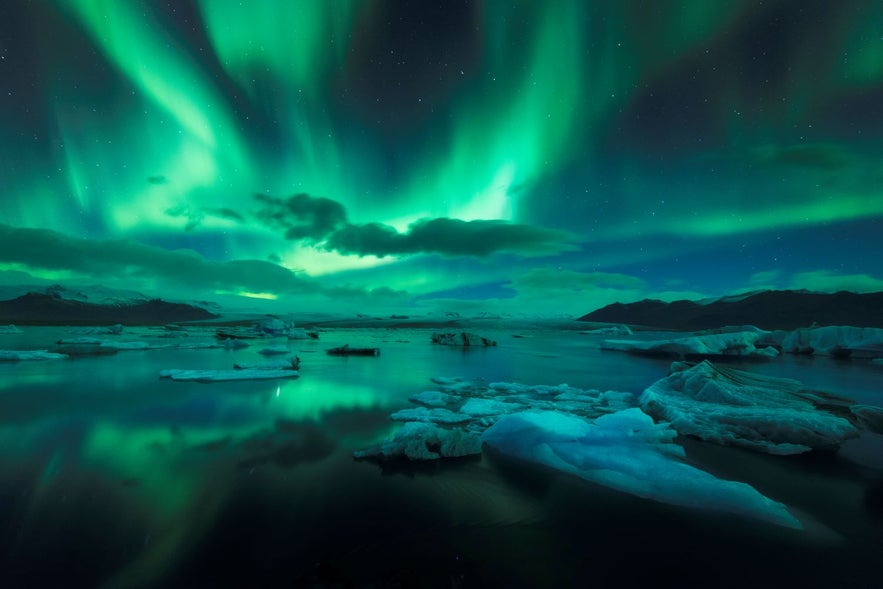 The northern lights can be seen from most places in Iceland if the conditions are right. Therefore, you can easily combine northern light hunting with a tour of the Icelandic countryside from Reykjavik! This will bring you many great photo opportunities at some of the country's majestic natural attractions and make your experience even more memorable.
The northern lights can be seen from most places in Iceland if the conditions are right. Therefore, you can easily combine northern light hunting with a tour of the Icelandic countryside from Reykjavik! This will bring you many great photo opportunities at some of the country's majestic natural attractions and make your experience even more memorable.
Doing a self-drive tour is a great option in the fall when the cold hasn't reached its peak and the weather is still relatively mild. If you're visiting Iceland in winter, we recommend opting for a guided tour instead, as driving conditions can be difficult, and road closures are common. This especially applies to those that not very comfortable driving in heavy snow, ice, and strong wind.
- Reykjanes peninsula: There are many locations along the Reykjanes Peninsula where you may spot the northern lights. Along the coastline, where the land meets the vast Atlantic, the dark, open skies provide an ideal canvas for the aurora surrounded by raw, lunar-like landscapes. You can stop in the towns of Grindavik, Keflavik, and Gardur along the way, where you can find the lovely Gardskagaviti lighthouses that make for great photos! We recommend paring your aurora hunt in Reykjanes with a visit to the nearby Blue Lagoon, as you may even witness the aurora while soaking in the warm water. Just make sure to book your Blue Lagoon tickets well ahead of time to guarantee a spot.
- The Golden Circle: Pairing northern light hunting with a visit to the Golden Circle is a great idea, as you'll have a chance to witness iconic locations under the dancing aurora, making for excellent photo opportunities. It's the most popular tourist route in Iceland for a reason, as it encompasses the historic Thingvellir National Park, the Geysir geothermal area, and the Gullfoss waterfall.
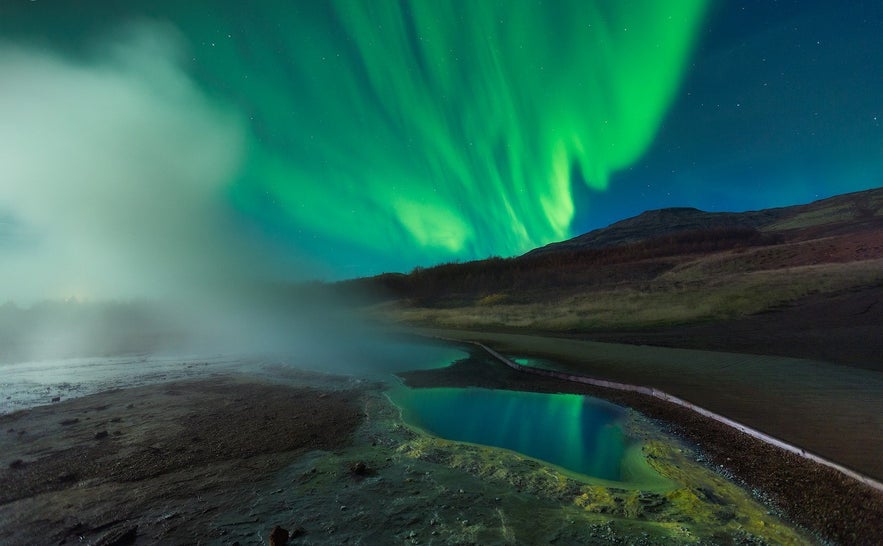
- Hvalfjordur: Hvalfjordur is a serene fjord located about an hour's drive north of Reykjavik. Its remote position ensures dark skies, and if the conditions are perfect, you may even see the aurora reflecting in the fjord's calm waters! In total, driving along the fjord takes about an hour, and a great way to maximize your experience is with a visit to the Hvammsvik Hot Springs, where you can unwind surrounded by nature. On the way, you can stop by the town of Akranes, where you can find a picturesque lighthouse.
- The South Coast: A northern light self-drive tour along Iceland's south coast offers the chance to explore some of the country's most iconic locations. You can find tranquil spots near Threngslin, like the Raufarholshellir lava cave, that provide an excellent opportunity for viewing the aurora. Waterfalls such as Seljalandsfoss and Skogafoss can provide a scenic backdrop for the lights as well as the famous black sand beaches of Reynisfjara, the Jokulsarlon glacial lagoon, and Diamond Beach. Along the way, you can stop in towns like Hveragerdi, Hella, and Vik.
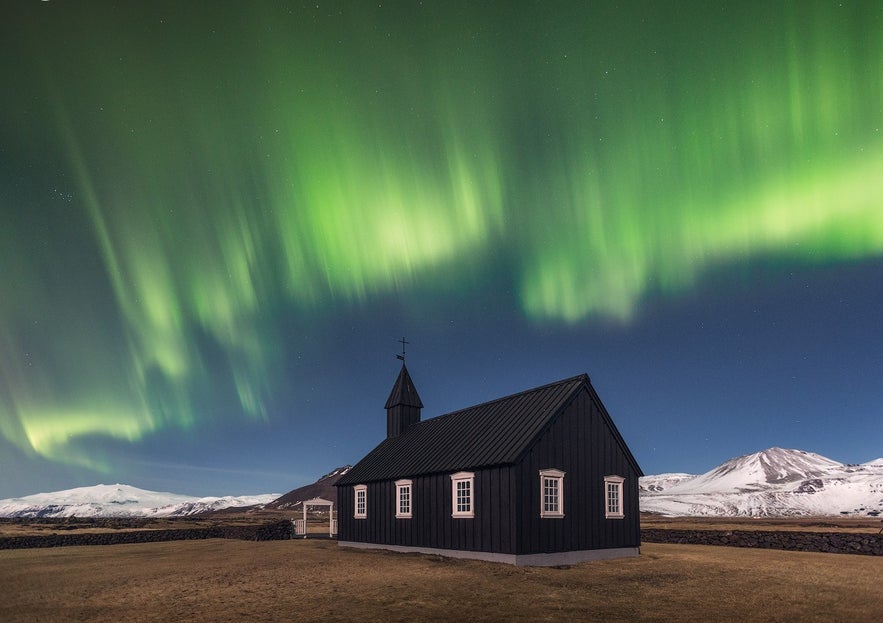
- Snaefellsnes peninsula: Hunting for the northern lights along the Snaefellsnes peninsula can be magical. The area features striking landscapes, like the iconic Kirkjufell mountain and the Arnarstapi cliffs, which offer a beautiful backdrop to the celestial display. Charming towns like Stykkisholmur and Olafsvik have low light pollution, which provides good viewing points. We recommend taking more than a day to explore Snaefellsnes as the peninsula has a lot to offer. Here, you can book accommodation in Stykkisholmur or in Olafsvik.
- Borgarfjordur: Borgarfjordur is a large fjord in West Iceland that offers great spots for viewing the northern lights. It's just over an hour's drive from central Reykjavik. You can stop in the fjord's largest town, Borgarnes, where you may spot the aurora due to low light pollution. Make sure to visit the Hraunfossar's cascading waterfalls, which will make good backdrops for the aurora or Deildartunguhver, Europe's most powerful hot spring. On the way, take a dip in the Krauma geothermal spa, heated by the Deildartunguhver hot spring!
There are many locations to choose from when going hunting for the northern lights from Reykjavik. If you want to explore larger areas, consider planning a multi-day trip to make the most of your journey and increase your chances of spotting the northern lights. Here, you can find great accommodation in Iceland. If you're planning a day trip from Reykjavik, make sure to account for the small amount of daylight that will be available during fall and winter.
Taking a Guided Northern Lights Tour from Reykjavik
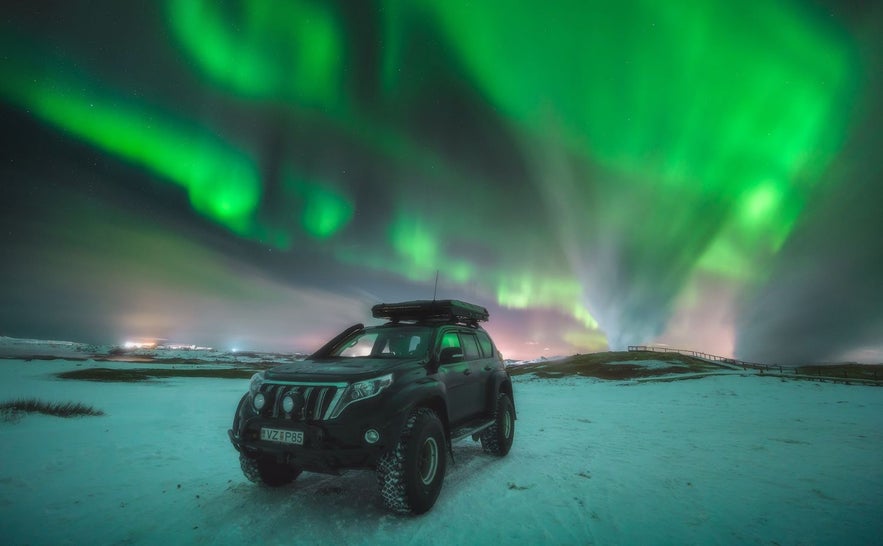 Guided northern lights tours in Iceland offer a well-structured and knowledgeable experience for those eager to witness the aurora. These tours are typically led by experienced guides who are adept at predicting potential sightings based on solar activity and local weather.
Guided northern lights tours in Iceland offer a well-structured and knowledgeable experience for those eager to witness the aurora. These tours are typically led by experienced guides who are adept at predicting potential sightings based on solar activity and local weather.
When you embark on a guided tour, transportation is either provided from your accommodation or from a convenient meet-up spot, and you'll head out in nature to carefully selected viewing spots away from city lights. This means you can focus on the experience rather than navigating unfamiliar roads at night.
There are also different types of northern lights tours that you can choose from, depending on your preference. Bus tours are popular as they are affordable and generally have a convenient time frame, like this popular three-hour northern lights bus tour. You can also go on a northern light cruise from Reykjavik harbor or a private super jeep tour with a photographer that can help you take the perfect aurora photos!
These tours may go to different locations depending on where the most aurora activity is expected. Some tours may also provide amenities such as warm drinks and blankets, which can be particularly welcoming given Iceland's chilly nights, and guides may even share stories, folklore, and other knowledge about the northern lights!
Remember, though, that nature is unpredictable, and sightings can't be guaranteed. However, many tour companies offer a second tour free of charge if the lights don't appear on your first trip or other similar compensation.
Self-Drive Tour vs. Guided Tour
 Hunting for the northern lights is an adventure, and both self-drive and guided tours offer unique advantages for this experience.
Hunting for the northern lights is an adventure, and both self-drive and guided tours offer unique advantages for this experience.
A self-drive tour provides the freedom and flexibility to hunt for the lights at your own pace and on your own schedule. If you're comfortable navigating Iceland's roads in the dark and adapting to weather conditions, this option allows you to explore various viewing locations beyond Reykjavik. This might also give you the chance to pair your hunt with other adventures, like a visit to a geothermal spa or a secluded waterfall under the aurora-lit sky.
Guided tours offer distinct advantages, particularly for first-time visitors or those less confident in handling Iceland's variable weather. Tour companies have expertise in predicting aurora activity and know the best viewing spots. They also handle all transport logistics, making the experience stress-free, especially in winter months when the weather conditions can be challenging.
Both options can offer a memorable experience. If you're planning on visiting Reykjavik without taking a rental car or prefer not to drive far, you can check out the many viewing spots close to the city center. However, we also recommend pairing a visit to those locations with a guided tour of the countryside for the optimal northern lights experience in Reykjavik.
Preparing For a Northern Light Hunt
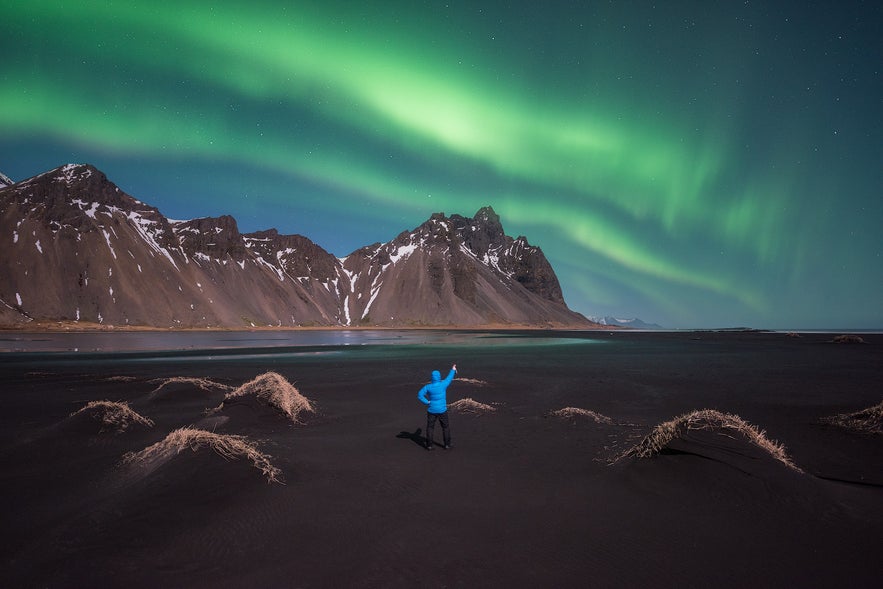 When embarking on a hunt for the northern lights in Reykjavik, take the time to prepare. Before heading out, check the weather forecast of the Icelandic Meteorological Office and the road conditions, especially in winter when conditions can be challenging. If driving, ensure your vehicle is suitable for icy roads. Avoid areas that are very remote unless with a guide, as it's easy to get lost in unfamiliar landscapes.
When embarking on a hunt for the northern lights in Reykjavik, take the time to prepare. Before heading out, check the weather forecast of the Icelandic Meteorological Office and the road conditions, especially in winter when conditions can be challenging. If driving, ensure your vehicle is suitable for icy roads. Avoid areas that are very remote unless with a guide, as it's easy to get lost in unfamiliar landscapes.
It's crucial to dress appropriately. Start with thermal base layers, including thermal leggings and a long-sleeved top. These trap warmth close to your body. Follow with insulating mid-layers such as fleece jackets or wool sweaters, and then add a waterproof and windproof outer layer. This layering approach allows you to add or remove layers as needed.
Don't forget your extremities. Warm wool or thermal socks, waterproof and insulated boots, gloves or mittens, and a warm hat or beanie are essential. Opt for touch-sensitive gloves if possible, so you don't have to take them off when adjusting camera settings.
If you're planning to be stationary for a while, consider bringing a thermal blanket or a heated seat pad for extra warmth. Also, pack a thermos for hot drinks! It can be a great way to warm up from the inside out while you wait for the lights to appear.
Lastly, never trespass on private property or drive off-road while seeking the perfect viewing spot. Always adhere to local laws and guidelines to ensure a safe northern lights adventure.
- See more: What to Pack for Iceland for All Seasons
Photographing the Northern Lights
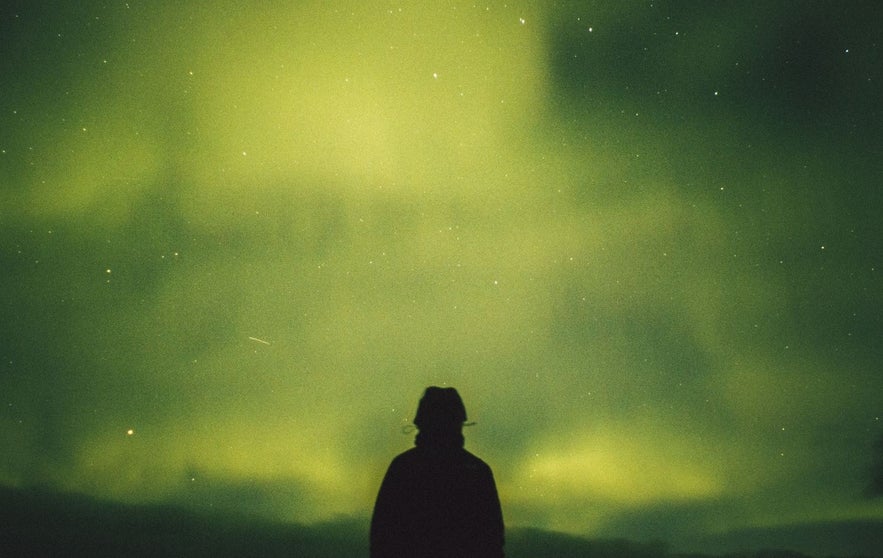
Photographing the northern lights can be tricky but can yield stunning results with a little planning and creativity. Keep in mind that you'll likely have to use a proper camera, as phones generally have a hard time capturing the aurora. Here are some tips to get you started.
- Stability is key: Use a tripod to stabilize your camera. The long exposure times required for northern light photography could lead to blurry images if the camera is handheld.
- Shoot Wide and High: Utilize a wide-angle lens to capture more of the sky, and don't forget to include some of the landscape to give a sense of scale and location.
- Experiment: Try different exposure lengths, but keep in mind that very long exposures may result in star movement, altering the final image.
- Focus: Ensure your camera is focused to infinity. In low light conditions, autofocus can struggle, so manual focus is usually best.
- Battery Power: Cold conditions can drain battery power quickly, so bring extras and keep them warm.
If you're not used to working with photography equipment but want nice photographs of the northern lights, consider joining a northern lights tour with a photographer! You can also visit the Aurora Museum in Reykjavik, where they can help set up your camera for the aurora. Remember to be patient as photographing the northern lights can often be a waiting game. Make sure to enjoy the experience beyond the lens, too!
Generally speaking, the aurora will appear stronger in photographs than you'll see them with the naked eye, so when the aurora activity appears faint, you can use your camera to help spot the lights in the sky.
- See more: How to Photograph the Northern Lights
Optimal Conditions For Seeing the Northern Lights in Iceland
 Witnessing the northern lights in Reykjavik, like anywhere else, depends on several optimal conditions converging. Here's what you need to look out for when hunting for them.
Witnessing the northern lights in Reykjavik, like anywhere else, depends on several optimal conditions converging. Here's what you need to look out for when hunting for them.
- Darkness: The skies need to be dark to spot the northern lights. This means the best times to see the lights are during fall and winter when daylight hours are minimal.
- Clear Skies: Cloud cover will obstruct the view of the northern lights, so cloudless or lightly cloudy nights are essential. Weather can be quite changeable in Iceland, so make sure to check the weather forecast.
- Low light pollution: While you can see northern lights in central Reykjavik if the aurora is strong, going to darker locations within or outside the city will increase viewing chances.
- Solar activity: The northern lights are the result of particles from the sun interacting with the Earth's magnetic field. Therefore, the stronger the solar activity, the more vibrant the lights.
It's important to remember that northern light sightings can never be guaranteed, even under optimal conditions. Nonetheless, when everything aligns, the sight of these dancing lights in the sky is an experience not to be missed. Look for these conditions, dress warm, and check the weather and aurora forecasts before heading out to increase your chances!
Aurora forecasts
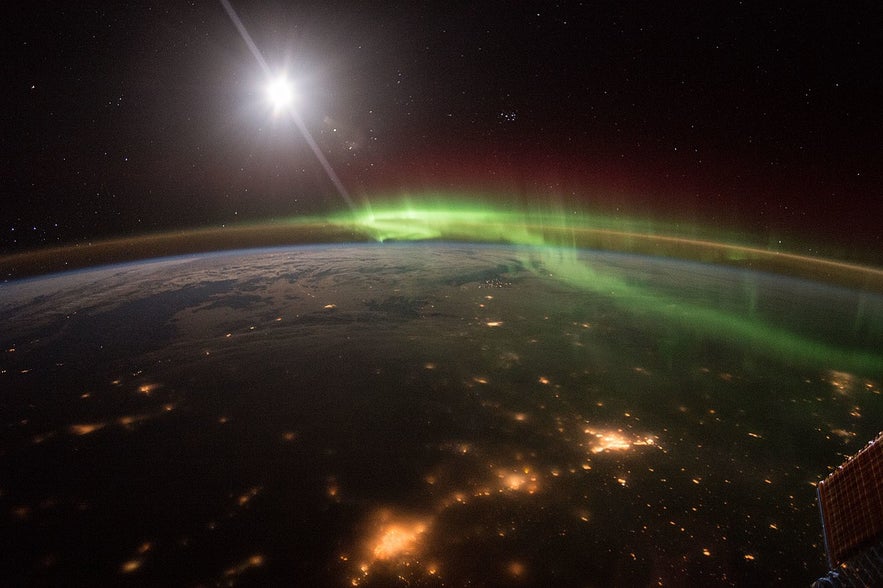
Photo from Wikimedia, Creative Commons, by NASA: The aurora borealis seen from the International Space Station. No edits made.
Aurora forecasts are valuable tools for those hoping to witness the mesmerizing northern lights in Iceland. These forecasts take into account solar activity and cloud cover, providing an estimated likelihood of viewing the lights on any given night.
The Icelandic Meteorological Office (IMO) offers an invaluable aurora forecast on its website. They provide a map of Iceland showing expected cloud cover and a scale from 0 to 9 indicating the strength of the auroral activity. This allows you to see at a glance the best areas for viewing based on current and predicted conditions.
Another resource is the Space Weather Prediction Center (SWPC), run by the National Oceanic and Atmospheric Administration (NOAA). On their website, you can find the NOAA northern lights forecast, where you can see the level of aurora activity.
Utilizing these forecasts, along with the weather forecast, can help guide your northern lights hunting endeavors. However, remember that these are predictions, and nature may have its own plans. Patience, persistence, and a bit of luck are always key in the quest to see the aurora borealis.
What Are the Northern Lights?
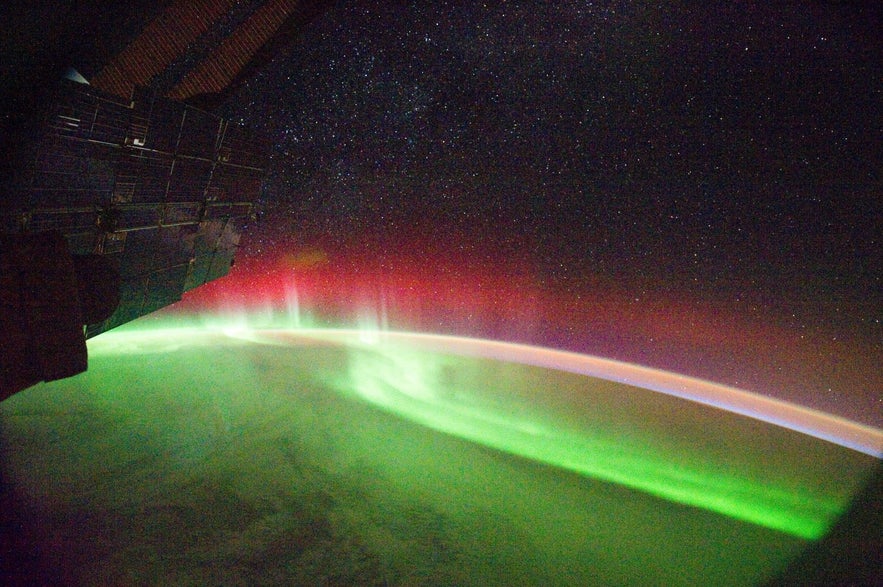
Photo from Wikimedia, Creative Commons, by NASA: The aurora borealis seen from the International Space Station. No edits made.
The northern lights, also known as aurora borealis, are a celestial phenomenon that has fascinated humans for centuries. But what exactly are these lights that dance across the night sky?
These beautiful lights are a result of collisions between electrically charged particles from the sun and gaseous particles in Earth's atmosphere. This interaction creates an array of colors that illuminate the sky, most commonly in vibrant shades of green but occasionally in hues of red, pink, and violet.
The intensity and frequency of these lights are influenced by solar activity, and they are most commonly observed in high-latitude regions around the Arctic and Antarctic, known as the "auroral zones." During periods of high solar activity, the auroras can extend further out of these zones.
The northern lights have a counterpart in the southern hemisphere known as the southern lights or aurora australis. These two phenomena are referred to together as aurora polaris or polar lights and occur simultaneously as mirror-like images of each other.
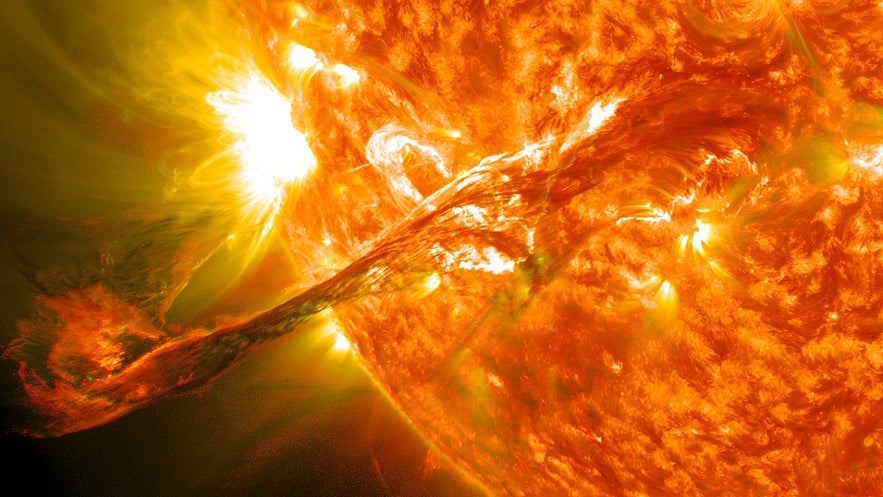
Photo from Wikimedia, Creative Commons, by NASA. A solar flare in 2012 led to increased northern lights on Earth. No edits made.
The intensity of the northern lights depends on solar activity. It is known to peak during periods of high solar activity, especially the solar maximum, which occurs approximately every 11 years. However, they can be observed to some extent when there is a dark, clear sky in the auroral zones.
Despite our understanding of the scientific principles behind the northern lights, they still inspire a sense of wonder. They have been the subject of numerous myths and legends, interpreted by some cultures as spirits of the dead or omens of war. In today's world, they attract thousands of visitors to high-latitude regions each year, all hoping to catch a glimpse of the celestial light show.
Visiting Aurora Museums in Reykjavik
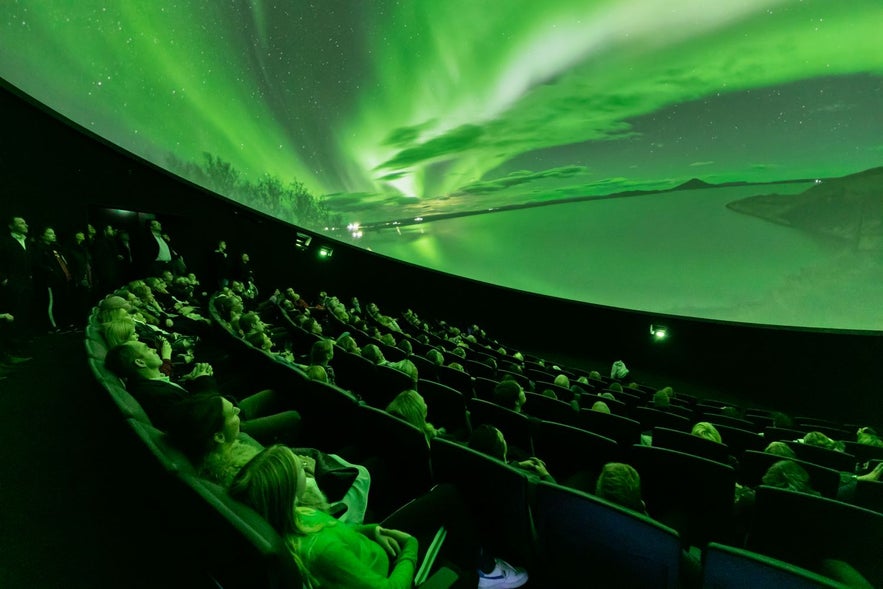 Don't despair if luck isn't on your side during your time in Reykjavik and conditions don't align for seeing the northern lights! There are places in the city where you can find excellent alternatives to seeing the aurora in real life.
Don't despair if luck isn't on your side during your time in Reykjavik and conditions don't align for seeing the northern lights! There are places in the city where you can find excellent alternatives to seeing the aurora in real life.
You can enjoy the northern lights show on display at the Perlan Planetarium to experience the aurora magic in a comfortable indoor setting. This immersive experience uses advanced technology to recreate the stunning aurora borealis phenomenon, letting you feel as though you're witnessing the real thing. The show is also very informative, as it explains the science behind the aurora's formation and delves into the folklore that has formed around them throughout history. You can book your Perlan northern lights show tickets now, and we also recommend checking out the fantastic Wonders of Iceland exhibition during your Perlan visit.
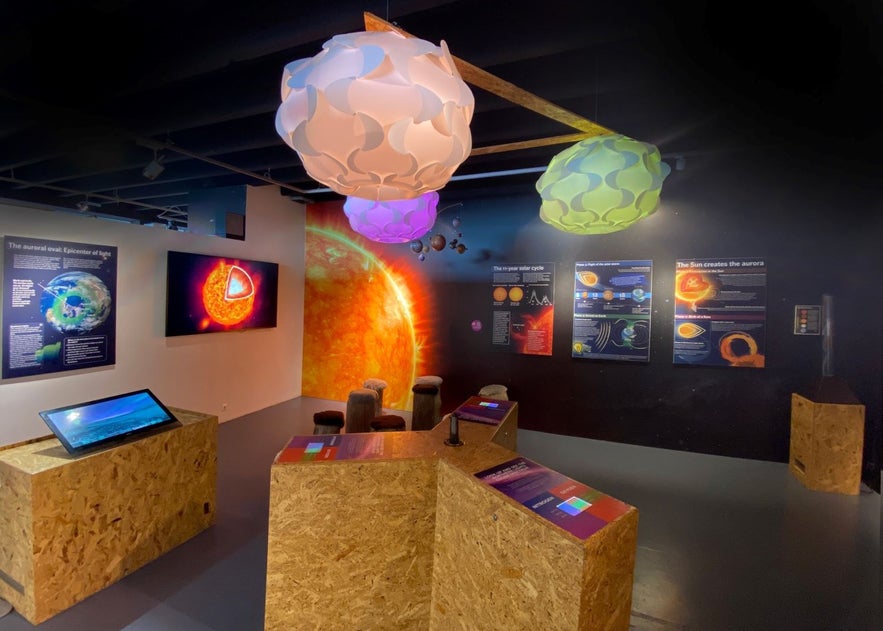 Another great place to visit is the Aurora Museum in the Grandi area. The museum is entirely dedicated to the northern lights and offers information about contemporary research related to this natural marvel as well as a deep dive into their cultural history. Interactive exhibits make it an engaging and educational visit for all ages, including a recreation of the conditions of northern lights for photography and experiencing the aurora through VR headsets. You can book your tickets to the Aurora Museum ahead of time before your visit to Reykjavik.
Another great place to visit is the Aurora Museum in the Grandi area. The museum is entirely dedicated to the northern lights and offers information about contemporary research related to this natural marvel as well as a deep dive into their cultural history. Interactive exhibits make it an engaging and educational visit for all ages, including a recreation of the conditions of northern lights for photography and experiencing the aurora through VR headsets. You can book your tickets to the Aurora Museum ahead of time before your visit to Reykjavik.
While it can't replicate the true grandeur of a live aurora, a visit to these attractions provides a great alternative, ensuring your trip to Reykjavik is unforgettable despite the weather. A visit is sure to enrich your appreciation of the aurora!
FAQs About the Seeing Northern Lights in Reykjavik
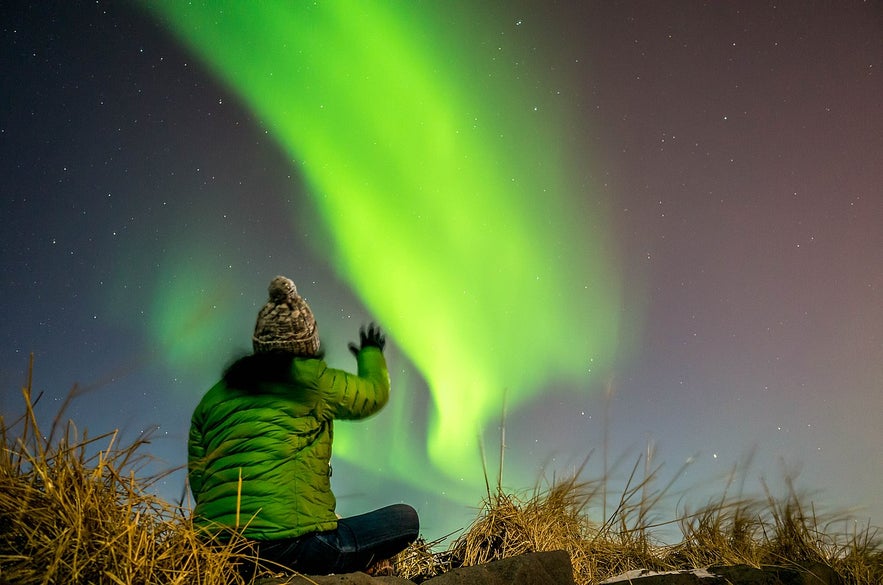
Photo from Wikimedia, Creative Commons, by sergejf. No edits made.
Here you'll find answers to the most frequently asked questions about seeing the northern lights in Reykjavik!
Do I need special equipment to see the northern lights?
The northern lights can be seen with the naked eye, so you don't need any special equipment. However, if you wish to photograph the aurora, a good quality camera with manual settings, a tripod, and some knowledge of nighttime photography are necessary.
Is it safe to drive in Iceland at night to watch the northern lights?
Yes, it's generally safe to drive at night in Iceland, but you should always be aware of the local weather conditions. Icelandic roads can be slippery and challenging to navigate in winter, especially in the countryside. Always check the weather and road conditions before setting out, and don't leave your car stopped on the road.
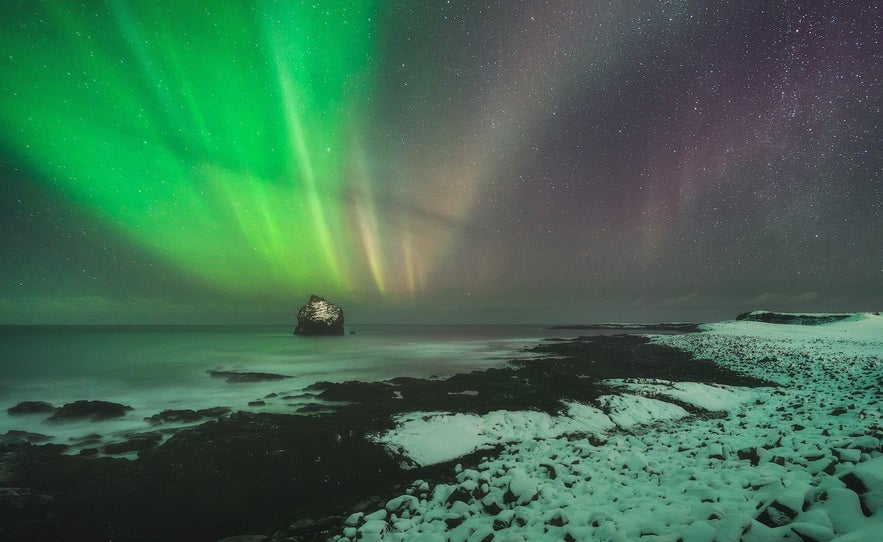
What should I do if my guided northern lights tour gets canceled?
Most northern lights tour operators in Reykjavik offer some form of compensation in case of cancellation due to poor weather conditions or low solar activity. It's common to offer another trip though this will not apply to all tour operators. It's advisable to book your tour early in your visit to Iceland to have flexibility for rescheduling if needed.
Are there any indoor places where I can view the northern lights in Reykjavik?
Unfortunately, you are unlikely to see the northern lights from indoors due to light pollution and the need for clear, dark skies. It's best to stay outside when hunting for the northern lights. However, at the Perlan Museum in Reykjavik, you can see a planetarium show about the northern lights at the Pearl Observatory.
Do the northern lights have a sound?
The northern lights do not make any sound. The phenomenon occurs high up in the atmosphere, far beyond the reach of human hearing. There are anecdotal reports of audible sounds like hissing or crackling during intense northern light displays, but they are not scientifically confirmed. This is likely due to other natural environmental noises occurring concurrently with the lights.
Summary of Seeing the Northern Lights in Reykjavik
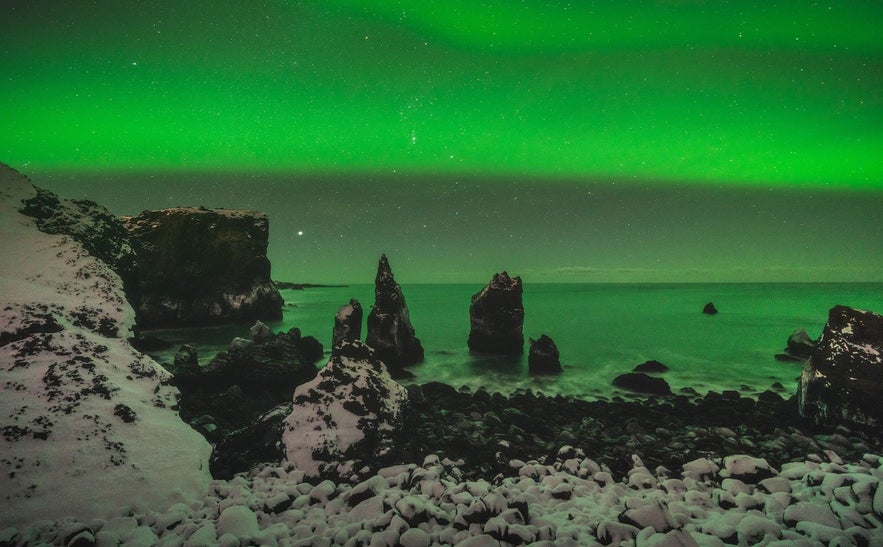 Hunting for the northern lights in Reykjavik can be an unforgettable adventure. By planning ahead, monitoring forecasts, and venturing to recommended locations, you can increase your chances of witnessing the elusive dance of lights. Whether it's the iconic landmarks, tranquil parks, or nearby natural wonders, Reykjavik offers a variety of settings to enhance your northern lights experience.
Hunting for the northern lights in Reykjavik can be an unforgettable adventure. By planning ahead, monitoring forecasts, and venturing to recommended locations, you can increase your chances of witnessing the elusive dance of lights. Whether it's the iconic landmarks, tranquil parks, or nearby natural wonders, Reykjavik offers a variety of settings to enhance your northern lights experience.
Remember to dress warmly, bring a tripod for photography, and be prepared to be patient. Whether you choose the convenience of a guided tour or the excitement of self-drive adventure, witnessing the northern lights is sure to be a highlight of your memories of Reykjavik.
Are you planning to go northern lights hunting in Iceland? Would you rather go on a guided tour or go adventuring yourself? Have you witnessed the aurora borealis? Share your thoughts in the comments below!
Andre interessante artikler
Den beste tiden å se nordlyset på Island
Finn den beste tiden på året for å se nordlyset på Island. Få mer informasjon om beste sesong og måned for å oppleve nordlyset på Island. Nordlyset er et av naturens mest magiske severdigheter, men...Les mer
Nordlyset på Island – Når og hvor kan jeg se nordlyset
Lær alt du trenger å vite om hvordan du kan se nordlyset på Island i denne omfattende guiden. Oppdag de beste stedene å se nordlys og lær om når du kan se det i løpet av året. Nordlyset er på drømme...Les mer

Last ned Islands største reisemarkedsplass på telefonen din for å administrere hele reisen på ett sted
Skann denne QR-koden med telefonen din og trykk på lenken som vises, for å legge til Islands største reisemarkedsplass. Legg til telefonnummeret ditt eller e-postadressen din for å motta SMS eller e-post med nedlastingslenken.
